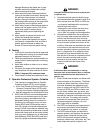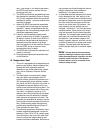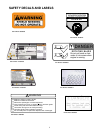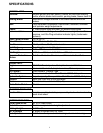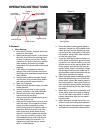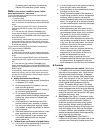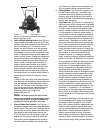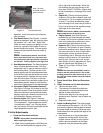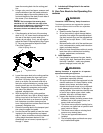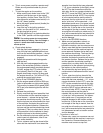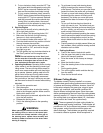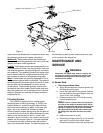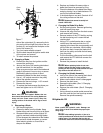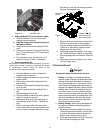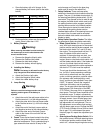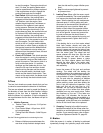
14
lower the mowing deck into the cutting posi-
tion.
b. Using a ruler, pencil and paper, measure and
note the distance from the paved surface to
the bottom edge of the mowing blade at the
front and the back of the deck on each side of
the mower. (Four dimensions.)
Note: The front edge of the mowing deck
should be 1/8"-1/4" below the rear edge of the
deck so that the blades are cutting grass in only
the front half of their circular path. This
decreases friction and reduces the drive power
required.
c. If the dimension at the front of the mowing
deck is 1/8"-1/4" lower than the dimension at
the rear of the deck on each side of the
mower, do not adjust. If not, you will need to
adjust the Deck Lift Spring Assist (See Figure
5). You may also need to adjust the Deck
Links (See Figure 5).
Deck Links
Deck Lift Spring inner nut
Figure. 5
d. Lower the mower deck to the cutting position.
With a wrench loosen the inner rear nut on
the Deck Lift Spring Assist. To adjust the
deck up or down, use a wrench and with a
few turns, adjust clockwise or counter clock
-
wise the outer rear nut of the Deck Lift Spring
Assist. Repeat this procedure on the oppo
-
site side of the Mower. Once the deck is
adjusted, retighten bolts.
e. With the deck still in the cutting position,
adjust the Deck Links. With a wrench loosen
the top inner bolt of the Deck Link. To adjust
the side of the deck up or down turn the top
bolt clockwise or counter clockwise a few
turns. Adjust both front and rear Deck links as
necessary. Retighten nuts.
f. Raise the mowing deck to the transport posi-
tion using the upper foot pedal.
g. Use the second foot pedal to lower the mow-
ing deck to the cutting position and repeat
step “b.” above to make sure that the desired
cutting height has been attained. If the
dimensions are not correct, repeat steps “c.”
through “f.” above.
5. Lubricate all fittings listed in the mainte-
nance section.
D. Zero Turn Break-In And Operating Pro-
cedures
DANGER:
Reread the “When Mowing” Safety Precautions.
The following procedures are suggested for operators
of ride-on machines which have zero turn capabilities.
1. Orientation:
a. Read the entire Operator’s Manual.
b. Sit on the machine, adjust the seat before-
and-after, then adjust the speed/directional
(lap bar) controls (they can be adjusted fore
& aft, as well as up & down — 9/16" wrench
required).
c. Become familiar with all of the machine con-
trols, instrumentation, safety and instruction
signs, and safety devices.
d. Move (or have moved) the machine to a safe,
level area with no obstructions including
objects, pedestrians, and animals.
2. Initial Operation:
a. Use protective equipment for eyes, hands,
hearing, feet, legs, head and other areas of
the body if needed — safety eye glasses,
gloves, earplugs, boots, hats, etc.
WARNING:
Hearing Protection is required for all operator
exposure exceeding two (2) hours.
b. Ensure that the area is free of animals and
bystanders, especially children!
c. Survey the area where the equipment is to be
used to make sure it is free of debris, sticks,
stones, wires, bones, and other foreign
objects which could cause injury to bystand
-
ers, damage to the machine, or damage to
nearby facilities. Also make sure that the area
is free of toys, stakes, pipes, chain, cable,
potholes, drop-offs, and step slopes.
d. Inspect the machine to make sure:
1. All guards, shields (including mower chute
deflector) are in their proper place, are
secure, and are functional.
2. That there are no spilled or leaking fuel or
oil sources, nor loose fuel or hydraulic tank
caps, hoses or fittings.
3. That there are no loose or missing hard-
ware nor any missing items.
4. That no non-approved devices are
installed.
5. That all safety signs and decals are prop-
erly installed and legible.



